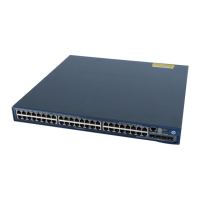105
An access port belongs to only one VLAN and sends traffic untagged. It is usually used to connect a
terminal device unable to identify VLAN tagged-packets or when separating different VLAN
members is unnecessary.
A trunk port can carry multiple VLANs to receive and send traffic for them. Except traffic of the port
VLAN ID (PVID), traffic sent through a trunk port will be VLAN tagged. Usually, ports that connect
network devices are configured as trunk ports.
Like a trunk port, a hybrid port can carry multiple VLANs to receive and send traffic for them. Unlike
a trunk port, a hybrid port allows traffic of all VLANs to pass through VLAN untagged.
Port VLAN ID (PVID)
By default, VLAN 1 is the PVID for all ports. You can configure the PVID for a port as required.
When configuring the PVID on a port, use the following guidelines:
Because an access port can join only one VLAN, its PVID is the VLAN to which it belongs, and it
cannot be configured.
Because a trunk or hybrid port can join multiple VLANs, you can configure a PVID for the port.
You can use a nonexistent VLAN as the PVID for a hybrid or trunk port but not for an access port.
After you use the undo vlan command to remove the VLAN that an access port resides in, the PVID
of the port changes to VLAN 1. The removal of the VLAN specified as the PVID of a trunk or hybrid
port, however, does not affect the PVID setting on the port.
NOTE:
Do not set the voice VLAN as the PVID of a port in automatic voice VLAN assignment mode. For information
about voice VLAN, see the chapter ―Voice VLAN configuration.‖
HP recommends that you set the same PVID for the local and remote ports.
Make sure that a port is assigned to its PVID. Otherwise, when the port receives frames tagged with the PVID or
untagged frames (including protocol packets such as MSTP BPDUs), the port filters out these frames.
The following table shows how ports of different link types handle frames:
Actions (in the inbound direction)
Actions (in the outbound
direction)
Tag the frame with the
PVID.
Receive the frame if its
VLAN ID is the same as
the PVID.
Drop the frame if its VLAN
ID is different from the
PVID.
Remove the VLAN tag and
send the frame.
Determine whether the
PVID is permitted on the
port, as follows:
If yes, tag the frame
with the PVID.
If not, drop the
frame.
Receive the frame if its
VLAN is carried on the
port.
Drop the frame if its VLAN
is not carried on the port.
Remove the tag and send
the frame if the frame
carries the PVID and the
port belongs to the PVID.
Send the frame without
removing the tag if its VLAN
is carried on the port but is
different from the default
one.

